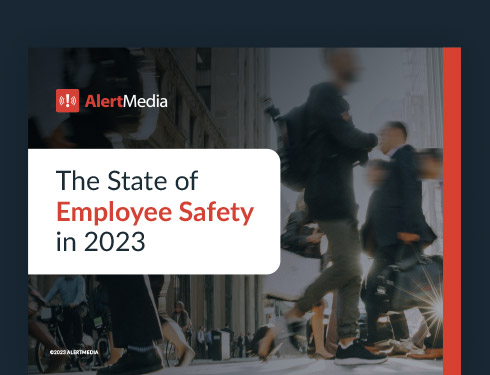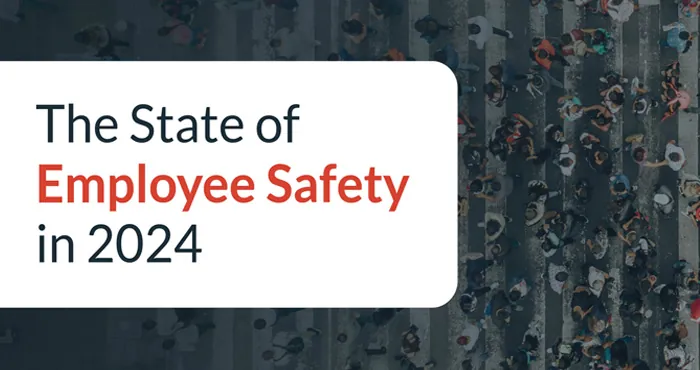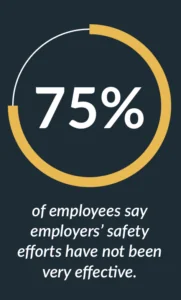
20 Workplace Safety Facts & Statistics to Guide Preparedness
To protect your workers, you need to know what you’re up against. Check out the latest workplace safety statistics and facts that can help you build a successful safety program.

Keeping employees safe is one of the most important responsibilities of an organization. Not only is it a moral obligation, but there is also a legal precedent—your duty of care—for protecting workers. Luckily, safety facts, statistics, and standards can inform response plans and training, helping organizations build safety programs, prevent work-related injuries, and save lives.
There are more resources than ever available to businesses to ensure they can keep their workers safe. Resources address everything from fall protection equipment and seat belts to protect workers on the job to safety training frameworks like tabletop exercises to train employees on how to prevent workplace accidents and fatal occupational injuries. Before you approach your safety program, it helps to understand the national landscape of dangers and safety incidents by looking at workplace safety statistics and safety facts.
Organizations such as the U.S. Bureau of Labor Statistics (BLS), the Occupational Safety and Health Administration (OSHA), Centers for Disease Control and Prevention (CDC), Department of Labor, National Highway Traffic Safety Administration (NHTSA), and the National Safety Council’s Injury Facts site gather comprehensive and reliable data on nationwide workplace injury rates, injury statistics, and safety trends. Many of the following facts are from their archives. AlertMedia’s State of Employee Safety Report provides unique insights into the views of workers themselves.
Our own research has shown that employees care more than ever about their safety on the job and expect their employers to provide a high degree of confidence that their workplace is safe. And with the right information about what is happening in the world of workplace safety, you’ll be better prepared to do just that. Read on to understand the trends that can inform your safety planning.
Workplace Safety Statistics in Perspective
General statistics
The following figures—gathered by trusted government agencies such as the BLS and OSHA—reflect the entire American workforce across industries and demographics. We’ll take a look at how these workplace statistics have changed and any meaningful trends.
#1: There were 2.61 million nonfatal workplace safety incidents in 2021.
These incidents include slips, trips, falls; illnesses; and other nonfatal injuries. This was a decrease of 1.8% from the 2.65 million in 2020.
#2: There were 5,190 recorded fatal workplace safety incidents in 2021.
This is an 8.9% increase from 2020’s 4,764 reported worker fatalities. This is also the highest annual rate since 2016.
#3: Worker deaths in America have decreased dramatically over the decades from about 38 worker deaths per day in 1970 to 13 per day in 2020.
However, there is still much work to be done to avoid preventable workplace deaths.
#4: Worker illnesses have also gone down significantly from 10.9 incidents per 100 workers in 1970 to 2.7 per 100 in 2020.
#5: Preventable deaths are increasing, with a 6% jump from 2020–2021 and a 14% rise since 2011.
After a dip in 2020, due to a decrease in hours worked because of the COVID-19 pandemic, preventable deaths in 2021 were the third highest since 2008.
What workers think
The landscape of workplace safety has changed in some big ways over the past few years. Here are some of the recent insights AlertMedia collected for our 2023 State of Employee Safety Report.
#6: 75% of employees say their employers’ safety efforts have NOT been very effective.
#7: The majority of workers (81%) say their physical safety is extremely important to them, but only 58% think their physical safety is extremely important to their employer.
#8: 42% of employees are working from home in some capacity, but remote workers feel their safety isn’t a priority.
Remote and hybrid employees are less likely to think their physical safety is “extremely important” to their employer and more likely to think productivity is “extremely important” to their employer.

#9: According to employees, improving communication and safety training are the most effective ways to make them feel like safety is a top priority and feel prepared to navigate a crisis at work.
#10: 83% of employees have encountered an emergency at work.
These emergencies range from severe weather to workplace violence and crime. Additionally, nearly half (45%) of employees are more concerned about a public health crisis at work than in previous years.
#11: Mental health is the second most important priority at work, with 77% of employees saying it is extremely important to them.
However, employees don’t think their mental health is as important to their organizations, with only 45% saying they think it is extremely important to their employer.

Business travel
#12: Business travel is back, with U.S. business travel by air predicted to recover to 98% of pre-pandemic levels in 2023.
And it’s only going to increase. Business travel is expected to hit 107% of 2019 rates in 2024.
#13: Air travel is getting more expensive, with a 28.5% rise in airfare year-over-year for 2022.
International flight costs have also seen a rise, with an increase of 17.1% from Q42019 to Q42022.
#14: 38% of employees are required to travel for work in some capacity.
#15: Safety is a top concern for business travelers, ranking second only to travel delays and disruptions.
Additionally, less than half (40%) of travelers reported feeling extremely safe when traveling for work.
#16: Employees are looking for increased safety monitoring while traveling for work.
23% of employees who travel for work said that increased monitoring during work travel would make them feel like their organization truly cares about their safety.
The most and least at risk
The risks a worker faces are influenced by their industry, demographic, and other factors. Here are some statistics that indicate higher-risk segments and others that are generally safer.
#17: In 2021, Black or African American workers and Hispanic or Latino workers had a higher fatality rate than the total worker group, with 4–4.5 deaths per 100,000 workers compared to 3.6.
Almost a quarter of workplace fatalities among Black or African American workers was due to violence—nearly 10% more than the all-worker rate. The second leading cause of fatality to Hispanic or Latino workers was slips, trips, or falls, after transportation incidents.
#18: Transportation incidents like motor vehicle crashes remained the leading cause of death for workers in 2021, up 11.5% from 2020.
Transportation fatalities accounted for 38.2% of all work-related fatalities in 2021.
#19: While women accounted for only 8.6% of workplace fatalities, they were a much higher proportion of intentional injuries at 14.5%.
#20: Technology and software employees and construction workers are less likely to know what to do in an emergency at work than employees in other industries.
Only 32% of tech and software employees and 36% of construction workers know what to do if they faced an emergency at work, compared to 41% of all employees. Workers in education are the most likely to feel prepared, with 50% saying they know how to handle an emergency at work.
Why Workplace Safety Facts Are Important
As your employees navigate their jobs from day to day, it’s easy to lose perspective on their relative safety. By remaining cognizant of the risks our own employees face, as well as the risks our neighboring industries deal with, we can continue making all jobs, all work environments, and all workers safer.
Not only is this the right thing to do morally, but it’s also good business. As our State of Employee Safety Report demonstrates, workers are becoming increasingly concerned with their health and safety on the job, and they’re expecting more from their employers in turn. Companies that navigate the dangers of their work and keep their employees out of harm’s way are far more likely to retain top talent and enjoy better brand recognition than their competitors. Being aware of common workplace hazards is only the first step toward meeting your organization’s duty of care. The critical steps you take next can make the difference for your employees’ ongoing health and safety.




![How to Create an Effective Workplace Safety Policy [+ Free Checklist]](https://www.alertmedia.com/wp-content/uploads/2022/02/Blog-HowTo-WorkplaceSafety-Policy.jpg)
